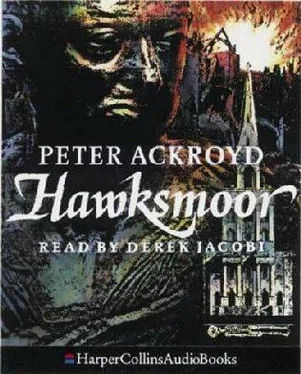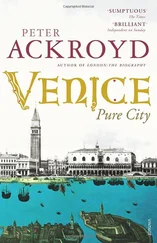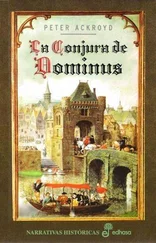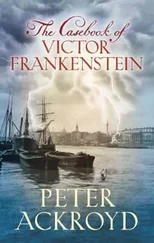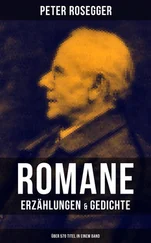'It has often been said that the more unusual the murder the easier it is to solve, but this is a theory I don't believe. Nothing is easy, nothing is simple, and you should think of your investigations as a complicated experiment: look at what remains constant and look at what changes, ask the right questions and don't be afraid of wrong answers, and above all rely on observation and rely on experience. Only legitimate deductions can give any direction to our enquiry.' A policewoman was now testing the video equipment which was being installed and, as Hawksmoor spoke, pictures from the various scenes of the murders -Spitalfields, Limehouse, Wapping and now Lombard Street -were appearing on the screen behind him so that momentarily he was in silhouette against the images of the churches. 'You see,' he was saying, The propensity for murder exists in almost everyone, and you can tell a great deal about the killer from the kind of death he inflicts: an eager person will kill in a hurried manner, a tentative person will do it more slowly. A doctor will use drugs, a workman a wrench or shovel, and you must ask yourselves in this case: what kind of man murders quickly and with his bare hands? And you must remember, too, the sequence of actions which follows the murder: most killers are stunned by their action. They sweat; sometimes they become very hungry or thirsty; many of them lose control of their bowels at the moment of death, just as their victims do. Our murderer has done none of these things: he has left no sweat, no shit, no prints. But one thing remains the same. Murderers will try and recall the sequence of events: they will remember exactly what they did just before and just after -' And at this point Hawksmoor always assisted them, since he liked to be entrusted with the secrets of those who had opened the door and crossed the threshold. He spoke gently and even hesitantly to them, so that they knew he was not judging them. He did not want them to falter in their testimony but to walk slowly towards him; then he might embrace them, in the knowledge they both now shared, and in embracing them despatch them to their fate. And when, after all the signs of fear and guilt, they confessed, he felt envious of them. He envied them the fact that they could leave him joyfully. '-But they can never remember the actual moment of killing. The murderer always forgets that, and that is why he will always leave a clue. And that, ladies and gentlemen, is what we are looking for. Some people say that the crime which cannot be solved has yet to be invented. But who knows? Perhaps this will be the first. Thank you.' And he stood very still as the incident officer for that morning arranged the men and women into various teams. A cat, adopted as a mascot, was accidentally kicked during these activities and ran screeching out of the room, brushing against Hawksmoor's right leg as he walked over to Walter who was now staring at the keys of a computer.
Walter sensed him at his shoulder: 'I don't know how you managed without them, sir,' he said without turning around, 'In the past, I mean.' After a noise which was as faint and yet to Hawksmoor as disquieting as a human pulse, certain letters and digits moved across the small screen. Walter now looked up at him in his eagerness: 'Do you see how it's all been organised? It's all so simple!'
'I seem to have heard that somewhere before,' Hawksmoor replied as he bent forward to look at the names and addresses of those convicted or suspected of similar crimes; and of those who had used a similar modus operandi -manual strangulation, with the murderer sitting or kneeling on the body of the victim.
'But it's much more efficient, sir. Think of all the agony it saves us!'
He now entered a different command, although his hands barely seemed to move across the keyboard. And yet despite his excitement it seemed to Walter that the computer itself only partly reflected the order and lucidity to which he aspired -that the composition of these little green digits, glowing slightly even in the morning light, barely hinted at the infinite calculability of the world outside. And how bright that world now seemed to him, as a face formed in an 'identikit' composition, flickering upon the screen with green shading in place of shadow so that it resembled a child's drawing. 'Ah,' Hawksmoor said, 'the green man did it.'
And when he grew bored with all this information, he decided that it was time to return to St Mary Woolnoth and resume the investigation there. It was almost midday when they reached it, and the autumn sun had changed the structure of the church so that once more it seemed quite strange to him. He and Walter were walking around to the side facing King William Street, when for the first time he noticed that there was a gap between the back of the church and the next building -an open patch of ground, part of which was covered with transparent sheeting. Hawksmoor looked down at the exposed soil and then drew back. 'I suppose,' he said, 'these are the excavations?'
'It looks like a rubbish tip to me.' Walter surveyed the deep furrows, the small pits with planks laid across them, the yellow clay, the pieces of brick and stone apparently thrown haphazardly to the edges of the site.
'Yes, but where did it come from? You know, Walter, from dust to dust…'
And his voice trailed off when he realised that they were being watched. A woman, wearing rubber boots and a bright red sweater, was standing in the far corner of the excavations. 'Hello love!' Walter shouted to her, 'We're police officers. What are you up to?' His voice had no echo as it passed over the freshly dug earth.
'Come on down and see!' she called back. 'But there's nothing here!
Nothing's been touched overnight!' In confirmation of this, she kicked a piece of plastic sheeting which remained firmly in place. 'Come on, I'll show you!'
Hawksmoor seemed to hesitate, but at this moment a group of children turned the corner into King William Street and he suddenly descended into the site by means of a metal ladder. Tentatively he crossed around the edge of the open pits, smelling the dankness of the earth as he did so. It was quieter here beneath the level of the pavement, and he lowered his voice when he reached the archaeologist: 'What have you found here?'
'Oh, flint blocks, some bits of masonry. That's a foundation trench there, you see.' As she talked she was scraping the skin off the palm of her hand. 'But what have you found?'
Hawksmoor chose to ignore the question. 'And how far down have you reached?' he asked her, peering into a dark pit at his feet.
'Well it's all very complicated, but at this point we've got down to the sixth century. It really is a treasure trove. As far as I'm concerned we could keep on digging for ever'. And as Hawksmoor looked down at what he thought was freshly opened earth, he saw his own image staring back up at him from the plastic sheeting.
'Do you mean this is the sixth century here?' he asked, pointing at his reflection.
'Yes, that's right. But it's not very surprising, you know. There's always been a church here. Always. And there's a lot more to find.'
She was certain of this because she saw time as a rock face, which in her dreams she sometimes descended.
Hawksmoor knelt down by the side of the pit; as he took a piece of earth and rubbed it between his fingers, he imagined himself tumbling through the centuries to become dust or clay. 'Isn't it dangerous,' he said at last, 'To dig so close to the church?'
'Dangerous?'
'Well, might it fall?'
'On us? No, that won't happen, not now.'
Walter, who had been examining the wooden supports which held up the church, had joined them: 'Not now?' he asked her.
'Well, we did find a skeleton recently. Not something you would be interested in, of course.'
But Walter was interested. 'Where did you find it?'
Читать дальше
